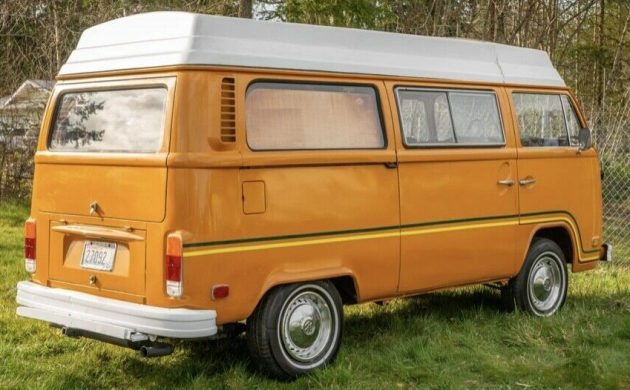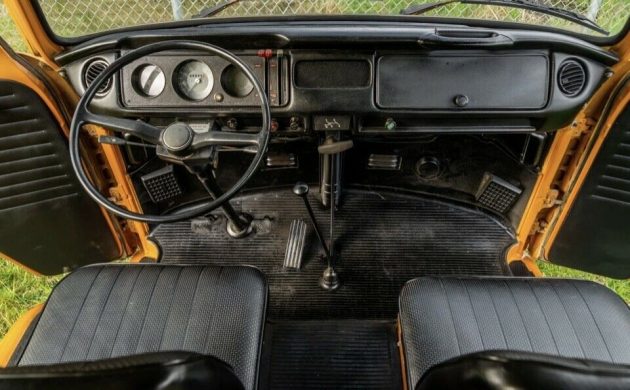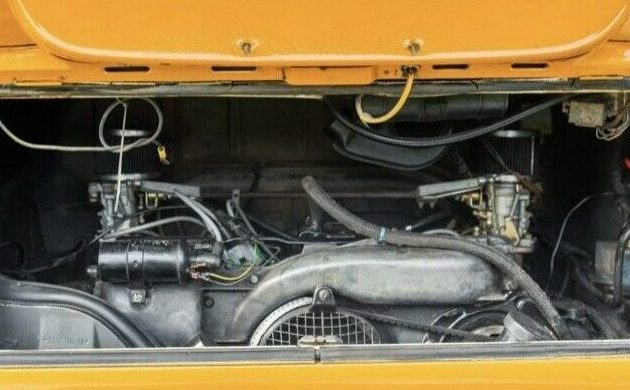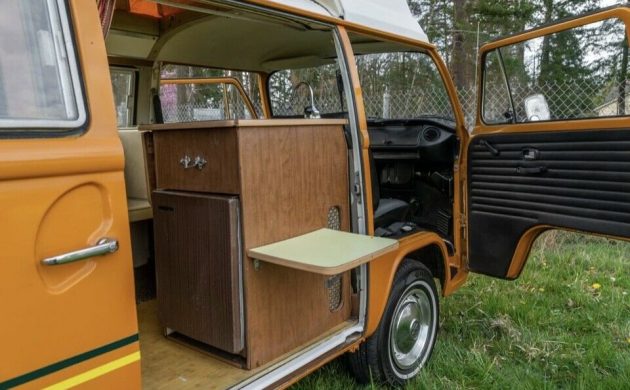Riviera Motors was a major Volkswagen distributor in Beaverton, Oregon, just miles from Portland, which was one of the main ports of entry for Volkswagen imports to the West Coast in the 1960s. During that time, Volkswagen camper vans were a hot commodity and Riviera could not satisfy demand with the limited amount of factory-authorized Westfalia camper converted vans they were allotted from Germany. As a result, in 1965 Riviera Motors partnered up with nearby Automotive Services, Inc. (ASI) to offer their own home-grown version of the Volkswagen Type 2 (Bus) camper, based on either the station wagon or panel van models. One such example is this 1973 Volkswagen Riviera Camper available here on eBay in Lakewood, Washington.
This Riviera, marketed as “the camper with the heart of a Volkswagen,” is finished in Sierra Yellow with dark green and light yellow stripes running down the sides. The original paint shines nicely, and the body is free of any rust or blemishes. The frame and floors are all solid as well with no noticeable corrosion. All glass is in good condition and the wipers, headlights, brake lights, and turn signals are said to be in working order. With the white fiberglass top it is easy to mistake this for the more common Westfalia conversion, but there is one key difference. Whereas the Westfalia “pop top” is hinged from either the front or back, the Riviera top opens vertically which provides a more spacious upper sleeping area.
Like the exterior, the interior is in great original condition. Up front, the seats and door cards are finished in well-preserved black vinyl, and the only noticeable flaw is a small crack in the dash behind the passenger’s grab handle. Like all other Type 2s, the dashboard instrumentation and controls are minimal and this one was never cut out for a radio.
In back, there is a sink with a refrigerator mounted below as well as a folding table. Seating surfaces are finished in a tan vinyl that matches the wood laminate surfaces found throughout. The rear bench seat folds into a double bed which, along with the bunk area above, provides sleeping accommodations for four adults. In the right rear just behind the sliding door is a small storage closet. A set of matched period-correct curtains finish off the cozy passenger/camping area.
Beginning in 1972, all US-market Type 2s were fitted with the Type 4 engine that was also used in the contemporary Porsche 914. Larger and more powerful, it was better suited to moving around a larger vehicle like the Bus. Though there are few details offered, this dual carburetor version was rebuilt around 50,000 miles ago and is said to run great. Receipts and maintenance records are included for the new owner.
At the time of writing bidding sits at $19,000 with just less than two days left in the auction. Prices of nice old Volkswagen camper vans aren’t going anywhere but up, so it’s hard to lose with one in this condition. This American-built Riviera conversion seems like a good alternative to the more common German-built Westfalia. What adventures would you take your Riveria Camper on?








Jonathan, you forgot to mention that this is a 4 on the floor manual transmission. (I found that out by reading the eBay ad).
Yes, most of them were manuals in ‘73 but that was the first year for the automatic transmission option.
These are, and always will be, “conversion vans”. They took a standard van or bus and cut a huge hole in the roof. This is where you insert the annoying buzzer sound. That weakens the whole structure of the vehicle! The Westfalia cans came down the VW assembly line to BE Westfalia campers. Early ones used the sunroof kombi body shell with the opening and all the reinforcement plates under the foor and elsewhere to replace the structure lost to the hole. 74 in, the whole roof and van structure is purposed designed for Westfalia to install their “stuff”. These “things” leak/squeak/rattle as the body flexes. Do not ever roll one over! And then the material and design of the interior parts…Wow..all laminated chipboard and screws on this with alpine birch plywood and galvanized fittings on a “westy”. Nope..nice bus, too bad it got all hacked up…
And, while I am ranting……
Whitewall tires are NOT correct for these vehicles! They require a “commercial” or “C” rated tire which is nominally a 6-ply OR what was known as a reinforced passenger tire. None of those were ever whitewall. That means the tires on it are overloaded already.
Also..just sayin, people who don’t know that a vw bus is a 4 speed really have no business thinking about having one. Buy an older bus and rue the day. Your mechanical learning curive will be vertical …
Seeing this brought back some old amazing memories! My aunt and uncle had the Westfalia, I believe a 74. My parents had a 71 Chevy Carryall, or Suburban to the younger crowd. We had a major summer road trip together in 1980 I believe it was, and we stayed in campgrounds and KOA’s from California up to & thru Canada, down to Yellowstone and then landing in Yosemite. My Dad put a mattress in the back of Carryall and we kids just played games and stuff, who needs seatbelts! Ahh, the good ol’ days!
I owned a ’78 ASI VW bus and drove it for some 60K miles. I can’t recall squeaks and rattles that amount to more than my original Westfalia. However, the pop top wasn’t roomier than the Westfalia, the opposite is true. It did afford more room for your feet, but the height at the hatch was barely enough to crawl up. The scissor mechanism kept chewing up the canvas, it was difficult to lower the top with something snagging. The Westfalia works much better. The cabinets were in typical RV fashion of the time. Flimsy and wasted much of the space with round fronts etc. I removed all the cheap particleboard cabinets and built sturdy plywood cabinets. Nevertheless, it was a great vehicle and I have many good memories exploring the US West Coast for an entire year.
Sweet looking Volkswagen camper van. I’d buy one if I had someone to share the experience and the responsibilities that come with owning a camper van.